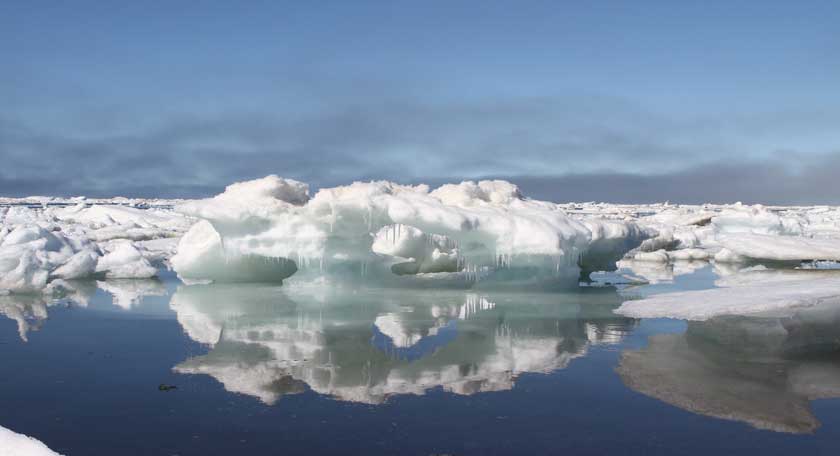February 2017 saw new records being established. Arctic sea ice extent for February 2017 averaged 14.28 million square kilometers (5.51 million square miles), the lowest February extent in the 38-year satellite record. This is 40,000 square kilometers (15,400 square miles) below February 2016, the previous lowest extent for the month, and 1.18 million square kilometers (455,600 square miles) below the February 1981 to 2010 long term average.
Now, let’s move on to the question of the moment.
Is this decline natural or man made?
A new paper has been published by Nature. Various media outlets have latched on to this paper and are running with the claim that much of the Arctic Sea Ice decline is natural and not caused by Climate Change at all.
For example …
- The Independent: Nature, not humans, could be cause of up to half of Arctic sea ice loss, study claims
- The Daily Mail (insert eye roll here): HALF of Arctic ice loss is driven by natural swings and not global
etc…
Most are running with the observation that humans are only responsible for half of the sea ice loss and the rest is “Natural”. This unfortunately might end up being fodder for the denialist camp.
OK, so let’s take a look at the actual paper itself and see what it actually tells us. You can find it here in full.
Influence of high-latitude atmospheric circulation changes on summertime Arctic sea ice
Here, we present evidence that trends in summertime atmospheric circulation may have contributed as much as 60% to the September sea-ice extent decline since 1979. A tendency towards a stronger anticyclonic circulation over Greenland and the Arctic Ocean with a barotropic structure in the troposphere increased the downwelling longwave radiation above the ice by warming and moistening the lower troposphere. Model experiments, with reanalysis data constraining atmospheric circulation, replicate the observed thermodynamic response and indicate that the near-surface changes are dominated by circulation changes rather than feedbacks from the changing sea-ice cover. Internal variability dominates the Arctic summer circulation trend and may be responsible for about 30–50% of the overall decline in September sea ice since 1979.
They basically present a plausible mechanism for how atmospheric circulation changes can impact Arctic sea ice, then move on to examine the potential for feedback impact by running two models, one that simply nudged the atmospheric circulation, and then a second that also included a slab ocean–sea-ice model in the Arctic (north of 60◦N), permitting a feedback from the ice–ocean system
Feedback?
This is where less sea ice yields dark ocean which in turn means more warming, hence a warmer atmosphere, which leads to less sea ice, etc… basically a feedback loop.
They then build on that and move on to run further simulations to example other possible variables.
The conclusion they reach is this …
we conclude that the JJA [June, July, August] vertical temperature trend in the Arctic in the past 36 yr is mainly controlled by the changes in the mid- and upper troposphere (top-down effect), rather than a bottom-up response due to the sea-ice melt.
… summertime circulation contributes to as much as 60% of the sea-ice loss since 1979. The magnitude of this estimate is perhaps not surprising given prior estimates linking roughly 60% of September sea-ice extent variance to sea-level pressure variability in the prior month
So far I have no quibbles.
What about “Natural” vs “anthropogenic”, where does that come into the mix?
They use the term “Natural” to describe changes in atmospheric circulation, and that is my quibble with all of this.
What they are suggesting is that what is going on in the tropics drives variations in atmospheric circulation, and it is those variations alone that have triggered about 60% of the sea-ice loss in the Arctic.
It is of course correct to think of the tropics as the powerhouse that drives our climate, and so what happens in the tropics ripples out across the planet. Their paper has now highlighted one such impact.
Where I do have my quibble is the implicit suggestion that such variations in atmospheric circulation are natural and not anthropogenic. We know that we are pumping vast amounts of carbon dioxide into our atmosphere, and we know that as much as 90% of the additional energy this traps ends up heating the oceans (I was writing about exactly that yesterday). That will feed into “natural” variations in atmospheric circulation that are not in fact natural at all but rather are firmly rooted in climate change.
So when sources such as phys.org are leaping to conclusions such as this …
Scientists have long accepted that natural changes in the environment, such as atmospheric air circulation, were at least partly responsible.
… then I do have to quibble about it by suggesting that this “natural” atmospheric air circulation variation that is impacting the arctic is simply another symptom of climate change. Unless they can eliminate that distinct possibility then they simply cannot conclude “natural”.

Dave,
Just saw this post. As a co-author of the paper, I want to respond to your quibble about the assumption that all circulation change is driven by natural variability rather than anthropogenic warming. We do in fact not make that assumption. We actually try to separate the anthropogenic and natural influences on the circulation. We find that 70% of the circulation variability is driven by natural variability, 30% by anthropogenic forcing. Using the 60% impact of circulation of sea ice loss we arrive at a total natural contribution of 30-50%. As with most new scientific results there is plenty of quibbling to be done, but not on this one I think. Hope that clarifies this.
Best Axel Schweiger